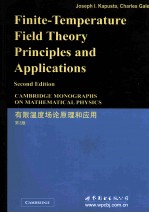图书介绍
有限温度场论原理和应用 原书第2版2025|PDF|Epub|mobi|kindle电子书版本百度云盘下载

- (美)卡普斯塔著 著
- 出版社: 北京:世界图书北京出版公司
- ISBN:9787510029660
- 出版时间:2011
- 标注页数:428页
- 文件大小:75MB
- 文件页数:442页
- 主题词:温度场-研究-英文
PDF下载
下载说明
有限温度场论原理和应用 原书第2版PDF格式电子书版下载
下载的文件为RAR压缩包。需要使用解压软件进行解压得到PDF格式图书。建议使用BT下载工具Free Download Manager进行下载,简称FDM(免费,没有广告,支持多平台)。本站资源全部打包为BT种子。所以需要使用专业的BT下载软件进行下载。如BitComet qBittorrent uTorrent等BT下载工具。迅雷目前由于本站不是热门资源。不推荐使用!后期资源热门了。安装了迅雷也可以迅雷进行下载!
(文件页数 要大于 标注页数,上中下等多册电子书除外)
注意:本站所有压缩包均有解压码: 点击下载压缩包解压工具
图书目录
1 Review of quantum statistical mechanics1
1.1 Ensembles1
1.2 One bosonic degree of freedom3
1.3 One fermionic-degree of freedom5
1.4 Noninteracting gases6
1.5 Exercises10
Bibliography11
2 Functional integral representation of the partition function12
2.1 Transition amplitude for bosons12
2.2 Partition function for bosons15
2.3 Neutral scalar field16
2.4 Bose-Einstein condensation19
2.5 Fermions23
2.6 Remarks on functional integrals30
2.7 Exercises31
Reference31
Bibliography31
3 Interactions and diagrammatic techniques33
3.1 Perturbation expansion33
3.2 Diagrammatic rules for λφ4 theory34
3.3 Propagators38
3.4 First-order corrections to ∏ and ln Z41
3.5 Summation of infrared divergences45
3.6 Yukawa theory47
3.7 Remarks on real time perturbation theory51
3.8 Exercises53
References54
Bibliography54
4 Renormalization55
4.1 Renormalizing λφ4 theory55
4.2 Renormalization group57
4.3 Regularization schemes60
4.4 Application to the partition function61
4.5 Exercises63
References63
Bibliography63
5 Quantum electrodynamics64
5.1 Quantizing the electromagnetic field64
5.2 Blackbody radiation68
5.3 Diagrammatic expansion70
5.4 Photon self-energy71
5.5 Loop corrections to ln Z74
5.6 Exercises82
References83
Bibliography83
6 Linear response theory84
6.1 Linear response to an external field84
6.2 Lehmann representation87
6.3 Screening of static electric fields90
6.4 Screening of a point charge94
6.5 Exact formula for screening length in QED97
6.6 Collective excitations100
6.7 Photon dispersion relation101
6.8 Electron dispersion relation105
6.9 Kubo formulae for viscosities and conductivities107
6.10 Exercises114
References115
Bibliography115
7 Spontaneous symmetry breaking and restoration117
7.1 Charged scalar field with negative mass-squared117
7.2 Goldstone's theorem123
7.3 Loop corrections125
7.4 Higgs model130
7.5 Exercises133
References133
Bibliography134
8 Quantum chromodynamics135
8.1 Quarks and gluons136
8.2 Asymptotic freedom139
8.3 Perturbative evaluation of partition function146
8.4 Higher orders at finite temperature149
8.5 Gluon propagator and linear response152
8.6 Instantons156
8.7 Infrared problems161
8.8 Strange quark matter163
8.9 Color superconductivity166
8.10 Exercises174
References175
Bibliography176
9 Resummation and hard thermal loops177
9.1 Isolating the hard thermal loop contribution179
9.2 Hard thermal loops and Ward identities185
9.3 Hard thermal loops and effective perturbation theory187
9.4 Spectral densities188
9.5 Kinetic theory189
9.6 Transport coefficients193
9.7 Exercises194
References194
10 Lattice gauge theory195
10.1 Abelian gauge theory196
10.2 Nonabelian gauge theory202
10.3 Fermions203
10.4 Phase transitions in pure gauge theory206
10.5 Lattice QCD212
10.6 Exercises217
References217
Bibliography218
11 Dense nuclear matter219
11.1 Walecka model220
11.2 Loop corrections226
11.3 Three-and four-body interactions232
11.4 Liquid-gas phase transition233
11.5 Summary236
11.6 Exercises237
References238
Bibliography239
12 Hot hadronic matter240
12.1 Chiral perturbation theory240
12.2 Self-energy from experimental data248
12.3 Weinberg sum rules254
12.4 Linear and nonlinear σ models265
12.5 Exercises287
References287
Bibliography288
13 Nucleation theory289
13.1 Quantum nucleation290
13.2 Classical nucleation294
13.3 Nonrelativistic thermal nucleation296
13.4 Relativistic thermal nucleation298
13.5 Black hole nucleation313
13.6 Exercises315
References315
Bibliography316
14 Heavy ion collisions317
14.1 Bjorken model318
14.2 The statistical model of particle production324
14.3 The emission of electromagnetic radiation328
14.4 Photon production in high-energy heavy ion collisions331
14.5 Dilepton production339
14.6 J/ψsuppression345
14.7 Strangeness production350
14.8 Exercises356
References358
Bibliography359
15 Weak interactions361
15.1 Glashow-Weinberg-Salam model361
15.2 Symmetry restoration in mean field approximation365
15.3 Symmetry restoration in perturbation theory369
15.4 Symmetry restoration in lattice theory374
15.5 Exercises377
References377
Bibliography378
16 Astrophysics and cosmology379
16.1 White dwarf stars380
16.2 Neutron stars382
16.3 Neutrino emissivity388
16.4 Cosmological QCD phase transition394
16.5 Electroweak phase transition and baryogenesis402
16.6 Decay of a heavy particle408
16.7 Exercises410
References411
Bibliography412
Conclusion413
Appendix417
A1.1 Thermodynamic relations417
A1.2 Microcanonical and canonical ensembles418
A1.3 High-temperature expansions421
A1.4 Expansion in the degeneracy423
References424
Index425
热门推荐
- 3238143.html
- 1464229.html
- 749807.html
- 3076081.html
- 3399569.html
- 3849552.html
- 3681568.html
- 1894217.html
- 900106.html
- 3798398.html
- http://www.ickdjs.cc/book_279525.html
- http://www.ickdjs.cc/book_741089.html
- http://www.ickdjs.cc/book_1291413.html
- http://www.ickdjs.cc/book_1610228.html
- http://www.ickdjs.cc/book_243511.html
- http://www.ickdjs.cc/book_1550885.html
- http://www.ickdjs.cc/book_2629051.html
- http://www.ickdjs.cc/book_3644864.html
- http://www.ickdjs.cc/book_3162069.html
- http://www.ickdjs.cc/book_2041087.html